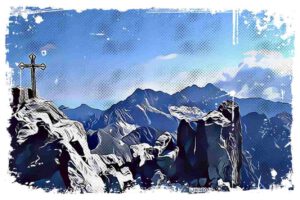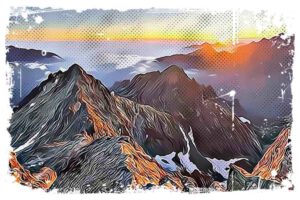The Valley of Five Polish Ponds is an absolute gem nestled within the High Tatras. I know it very well, I’ve been there 8 or 10 time. Four times in the winter. For me it’s no wonder that it draws in heaps of visitors from all corners of Poland each year. If you want to soak up some breathtaking scenery, this majestic valley brimming with stunning mountain lakes is the place to be.
I am convinced that you’ll be left in awe by the longest and deepest Tatra lake, Wielki Staw Polski (The Great Polish Pond). What’s more, the highest situated mountain shelter in Poland also calls this valley home.
A day trip to the Valley of Five Polish Ponds is a fantastic idea. In fact, it’s also a great jumping-off point for exploring higher parts of the High Tatras. In this blog post, you’ll get all the info you need about the trails, parking, and entry fees. I’ve even put together a detailed description of the whole trip for you.
Where Exactly is This Valley of Five Polish Ponds?
The Valley of Five Ponds holds the title of the highest situated large valley in the Polish Tatra Mountains. I know it might sound a bit complicated, but it’s basically a part of the Białka Valley and the upper section of the Roztoka Valley.
↳ Before you head to Tatra Park, I highly recommend reading my complete guide to Tatra Mountains. I showcase the most scenic places you won't want to miss. Make sure to check it out, so you don't overlook anything interesting: Tatra Mountains – An Insider’s Guide to All Attractions and Info
Here’s a interesting fact – the Valley of Five Polish Ponds is nestled right in the heart of the Polish High Tatras. From the west and south, it’s bordered by the main ridge of the Tatras extending from Świnica to Szpiglasowy Wierch.
Orla Perć, the most spectacular ridge of the entire Tatra Mountains available to tourists, shuts off the valley from the north. Meanwhile, the Miedziany and Opalone ridges limit the valley from the east.
If you need directions to Morskie Oko, there are two trails: through Świstówka and Szpiglasowa Pass. Being there, you need to know that both trails are equally enchanting.
Unfolding the Beauty of the Valley
Here’s what makes the Valley of Five Polish Ponds stand out. It’s a post-glacial valley that stretches over 4 km and covers an area of 6.5 km². Picture this – you’re standing at an altitude of around 1625-1900 m above sea level, surrounded by the granite peaks of the High Tatras, vast plains, and large boulders scattered around.
Imagine screes, sparkling lakes, grasslands, and patches of mountain pine adding to the beauty of the scene. I can tell, it’s like being in a beautiful painting.
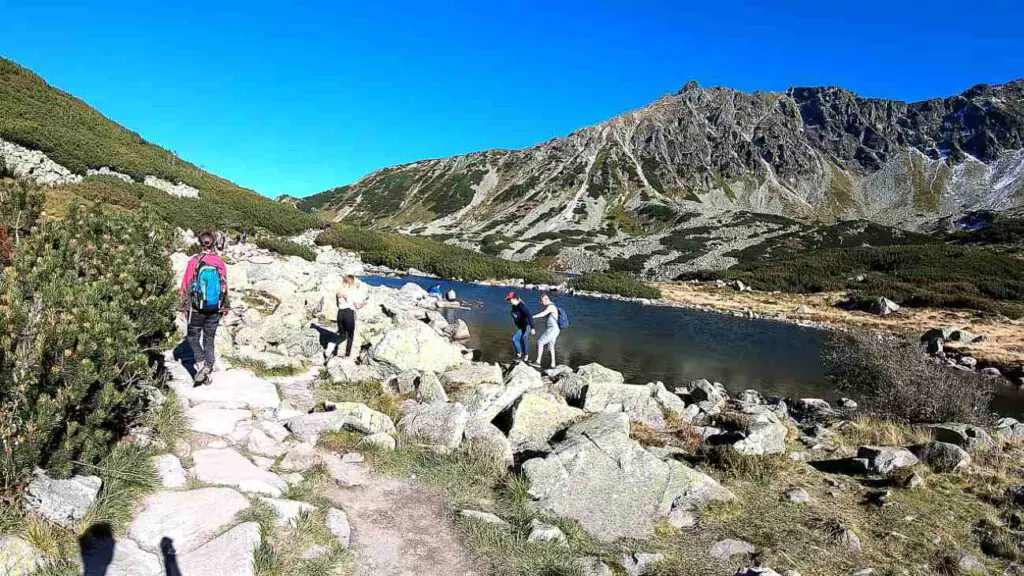
The glacier has done a fantastic job of carving out a large crescent-shaped floor in the valley. What’s more, the valley houses several glacial lakes that collectively cover an area of 61 ha. The star attraction is Wielki Staw Polski, the largest lake located at an altitude of 1665 m above sea level. And let’s not forget the other beautiful lakes: Zadni Staw Polski, Czarny Staw Polski, Mały Staw Polski, Przedni Staw Polski.
Accommodation Options for Hiking Five Ponds Valley
I totally recommend staying in Zakopane if you plan to visit Five Ponds Valley or Morskie Oko. No only because you will easily find a transport options to Tatra Park, but you will also enjoy your stay in this small town. Here are my top three picks across different price ranges in terms of accommodation for Five Ponds Valley.
- (€) Hotel Tatra: A brilliant, budget-friendly modern 3-star which is located in Zakopane, at an altitude of 1080 meters above sea level. It has indoor swimming pool, free Wi-Fi and classically furnished rooms with a beautiful view of the Tatra Mountains.
- (€) ❤️ Bachleda Residence Zakopane: A gorgeous hotel located less than 1 km from Aqua Park Zakopane. There is a bar and private parking on site. There is a restaurant in the facility. It offers air-conditioned luxurious rooms. Beautifull place!
- (€) Hotel Paryski Art&Business: This 4-star hotel has a seasonal outdoor swimming pool, free private parking, a garden and a shared lounge. It offers a restaurant, a terrace, an indoor swimming pool and a sauna.
🌃 Find more accommodations in Zakopane at the best price 👈
The Trails To The Five Ponds Valley
There’s no shortage of hiking trails leading to the Valley of Five Polish Ponds. I believe the most popular and easiest route starts from the car park at Palenica Białczańska. You’ll need to walk for about 50 minutes to reach waterfalls called Wodogrzmoty Mickiewicza. From there, follow the green trail straight to the Valley of Five Polish Ponds.
- Wodogrzmoty Mickiewicza Waterfalls to Wielki Staw (Great Pond) : About 2 hours (1:30 back).
There’s more. Check out these other trails in the area:
- From Morskie Oko Lake through Świstówka and Zawrat pass to Dolina Gąsienicowa: It takes about 2 hours (1:40 hours back) to reach the hostel from Morskie Oko. Add another 4 hours if you’re heading to Dolina Gąsienicowa through Zawrat.
- From Morskie Oko through Szpiglasowa Pass to the Valley of Five Polish Ponds (approx. 3:30 h, 3 h back), and then to Kozia Pass (approx. 1:20 h).
- From the Great Pond to Kozi Wierch (Peak): This one’s a 1:30 h upwards journey.
- From the Great Pond to the Krzyżne Pass: Expect to hike upwards for 1:50 h.
Starting From Palenica Białczańska
Time: 5 hours 30 minutes. Distance: 15.80 km. Sum of ascents: 797 m.
Our journey to the Valley of Five Polish Ponds began in Palenica Białczańska. We chose to take the Zakopane buses to Palenica to save on parking fees and the hasle of reserving a parking spot. The bus ride to Palenica Białczańska takes about 35 minutes and costs around PLN 15 one way.
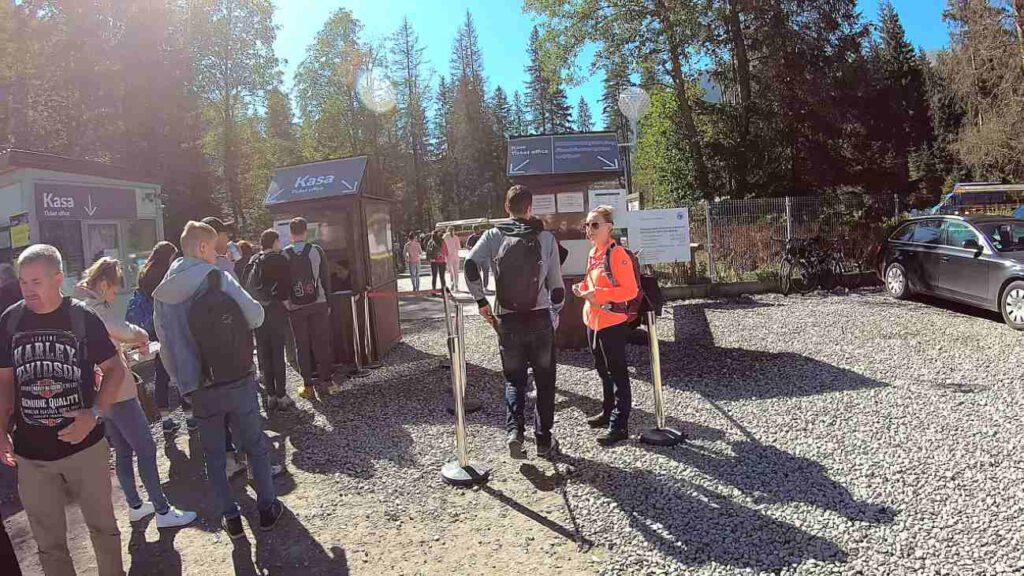
Upon arrival, we headed straight to the entrance of the Tatra National Park, stamped our pre-purchased e-tickets at the ticket office, and hit the trail. If You want, book your e-ticket for the car park in Palenica Białczańska right here.
The first leg of the journey to the Valley of Five Polish Ponds involved covering an almost 3-kilometre stretch of the asphalt road – Oswald Balzer Road. This is one of the most renowned and popular roads in the Polish Tatras, leading directly to Morskie Oko.
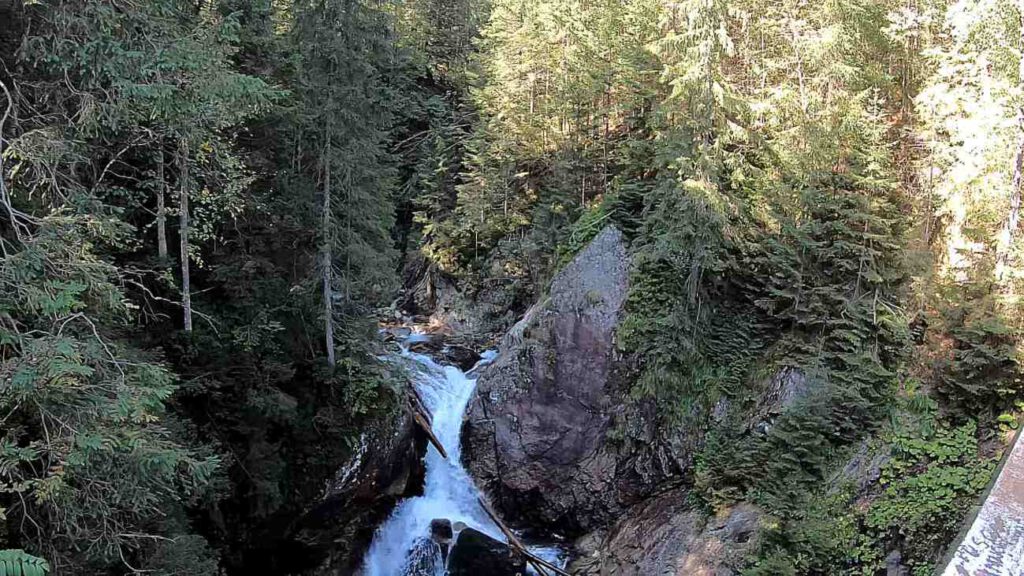
We followed the Oswald Balzer Road only to Wodogrzmoty Mickiewicza Waterfalls, where we found the start of the green tourist trail. The Oswald Balzer route offers magnificent views of the High Tatras throughout, making for a delightful mountain atmosphere.
The first leg of the journey to the Valley of Five Polish Ponds wraps up at Mickiewicz Waterfalls. After about 45 minutes of walking, it’s time to take a break and marvel at the stunning waterfalls. At Wodogrzmoty Mickiewicza Waterfalls, you’ll find a large square with several TOI-TOI toilets and numerous wooden benches.
This area gets crowded in the summer since this is where the trails leading to Morskie Oko and the Valley of Five Polish Ponds intersect. As we rest under a tree, we watch horse-drawn carriages, loaded with tourists, pass us one after the other.
Most tourists head towards Morskie Oko Lake, either on foot or by availing the services of Fiakers, who offer rides in horse-drawn carriages. However, we take a right at Wodogrzmoty Mickiewicza Waterfalls and embark on the green tourist trail.
The walk from the Mickiewicz Waterfalls to the Valley of Five Polish Ponds takes roughly 2 hours and 10 minutes. Now begins the second part of our trip.
Hiking Further Through Roztoki Valley
The green trail that begins at Wodogrzmoty Mickiewicza takes you through the beautiful Roztoki Valley. While this valley is often overlooked by tourists as a standalone point of interest and seen more as a fixed part of the route to the Five Polish Ponds, it’s truly a remarkable place. The Roztoki Valley is a narrow, deep valley stretching over 4 kilometers.
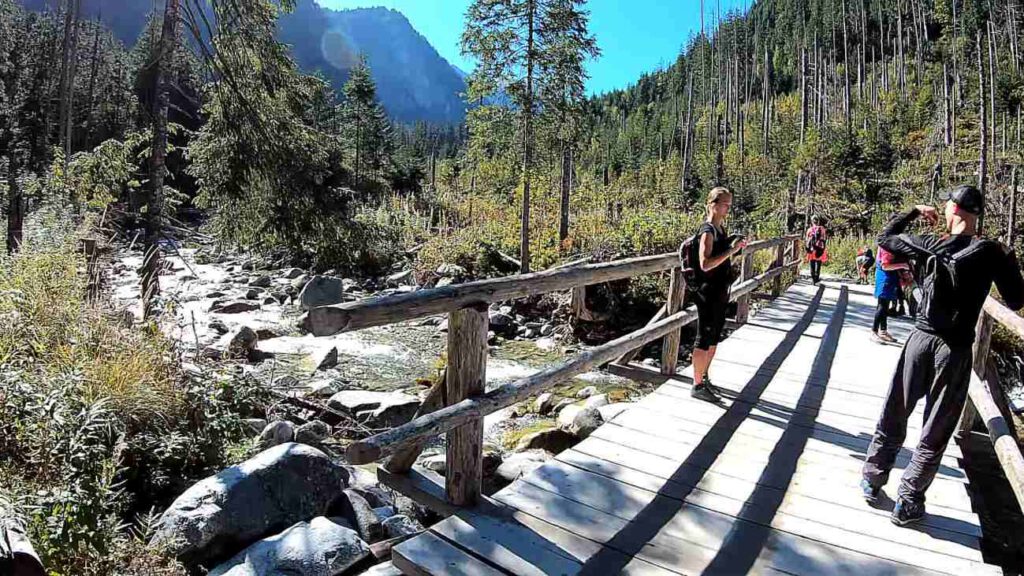
It’s surrounded by the breathtaking, tall peaks of the Tatra Mountains such as Turnia Nad Szczotami (1741 m above sea level) or Roztocka Czuba (1425 m above sea level). As you delve deeper into the Roztoki Valley, to your right, you’ll see the peaks of Wielki Wołoszyn, Pośredni Wołoszyn, and Skrajny Wołoszyn – all towering over 2000 meters above sea level. Roztoka Creek, a beautiful stream, also flows through the Roztoki Valley.
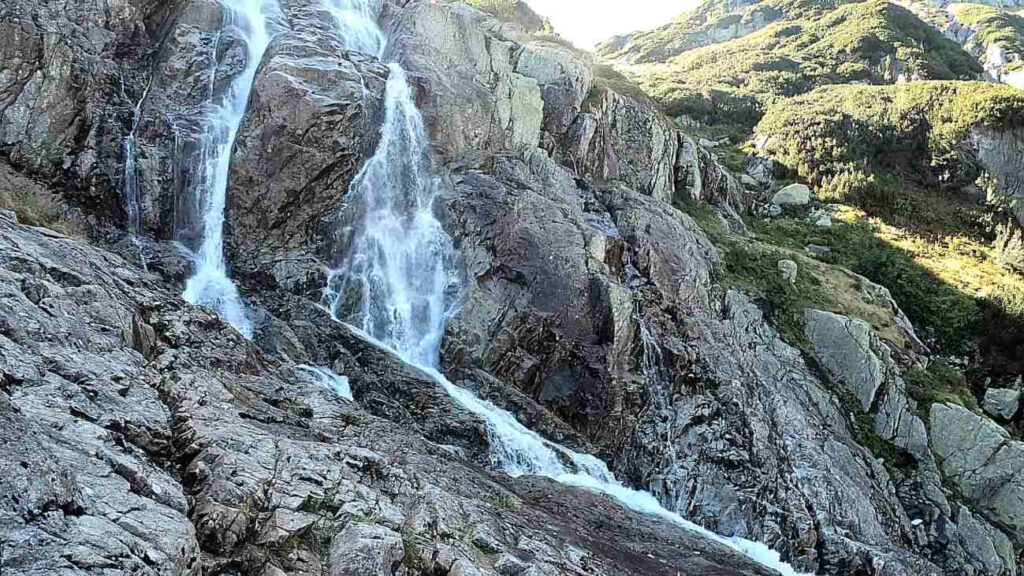
Strolling along the Roztoki Valley is pretty much a delight. The green trail gently ascends, making for a pleasant walk rather than a strenuous mountain hike. The difficulty level spikes towards the end of the valley, near the captivating Siklawa waterfall. Located about 120 meters from Wielki Staw (The Great Pond), this is the highest waterfall in the Polish Tatra Mountains.
Here, you’re faced with a steep climb up the rocks, which can be slippery due to the water. During our journey, the TOPR helicopter intervened twice in this area as two individuals slipped on the wet trail and tumbled down the rocks in quick succesion. So, be extremely cautious on this section of the trail. Once you ascend a little higher, all the effort you’ve put into the climb will be rewarded with fantastic views of the entire Siklawa waterfall.
Adventurous Trails To Five Ponds Valley With Licensed Guide
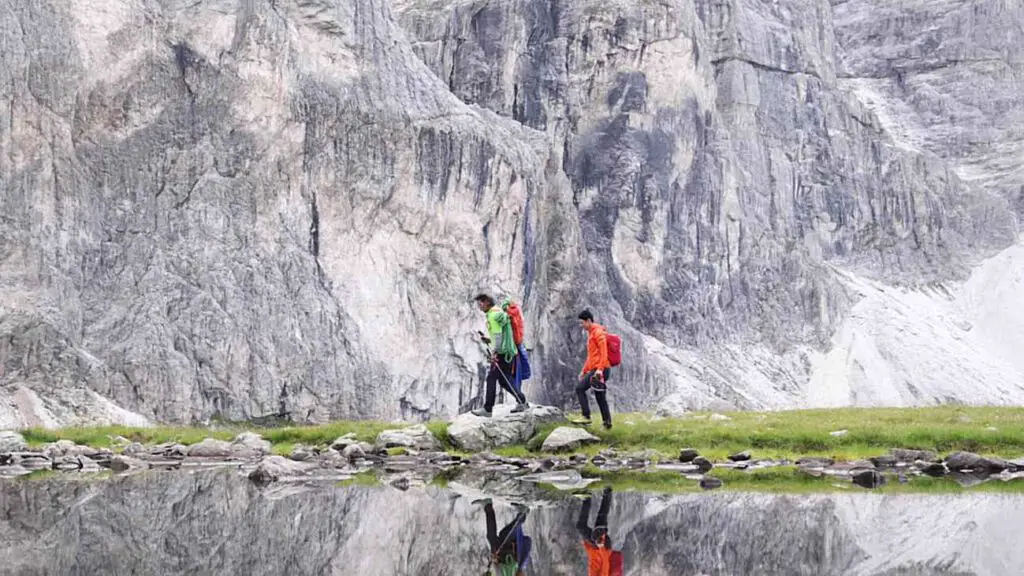
Think of the guide as your personal narrator, breathing life into the surrounding landscape with their enlightening commentary. And let’s be honest, this makes the journey much more engaging, don’t you think?
Sometimes if it’s worth hiring a local tatra guide because he will also take care of your safety in Tatra Mountains.
↳ Book adventurous guided tours in Tatra Mountains by clicking here!
Unveiling the Beauty of Five Polish Ponds Valley
After an adventurous hike of about eight kilometers lasting three hours, we finally reach our destination – the enchanting Valley of Five Polish Ponds. You may be wondering, „Where does this valley get its unique name?” Well, let me say, it’s named after the post-glacial ponds nestled within it. You can spot following ponds:
- Wielki Staw Polski – the largest and deepest lake in the Tatra Mountains sitting at an altitude of 1665 meters above sea level
- Zadni Staw Polski
- Czarny Staw Polski
- Mały Staw Polski
- Przedni Staw Polski
Besides these, you’ll also discover the so-called Wole Oko, a small seasonal lake that isn’t included in the valley’s name because it’s not always there. The first pond that will catch your eye as you step into the Valley of Five Polish Ponds is the majestic Wielki Staw Polski (Great Polish Pond). To explore the rest of the ponds, I recommend following the blue tourist trail towards Zawrat.
I know the climb might be challenging, but trust me, it’s totally worth it. You’d also stumble upon trails leading to Kozi Wierch Peak and the famous Orla Perć Range.
Taking a left turn at Wielki Staw Polski, we stick to the blue trail, heading towards Przedni Staw Polski. This pond lies at an altitude of 1668 meters above sea level and plunges as deep as 34.6 meters. It’s flanked by the slopes of Opalony Wierch Peak from the south and by the peaks of Wyżnia and Niżnia Kopa from the north.
I can tell you, the sight is mind-blowing! The azure water of Przedni Staw reflects the Tatra peaks, creating a magical effect. As you saunter along the blue trail next to this lake, you’ll pass the TPN guardhouse and eventually reach the highest mountain shelter in the Polish Tatras, the PTTK Mountain Shelter in the Valley of Five Ponds.
The Inviting PTTK Shelter Amidst the Ponds
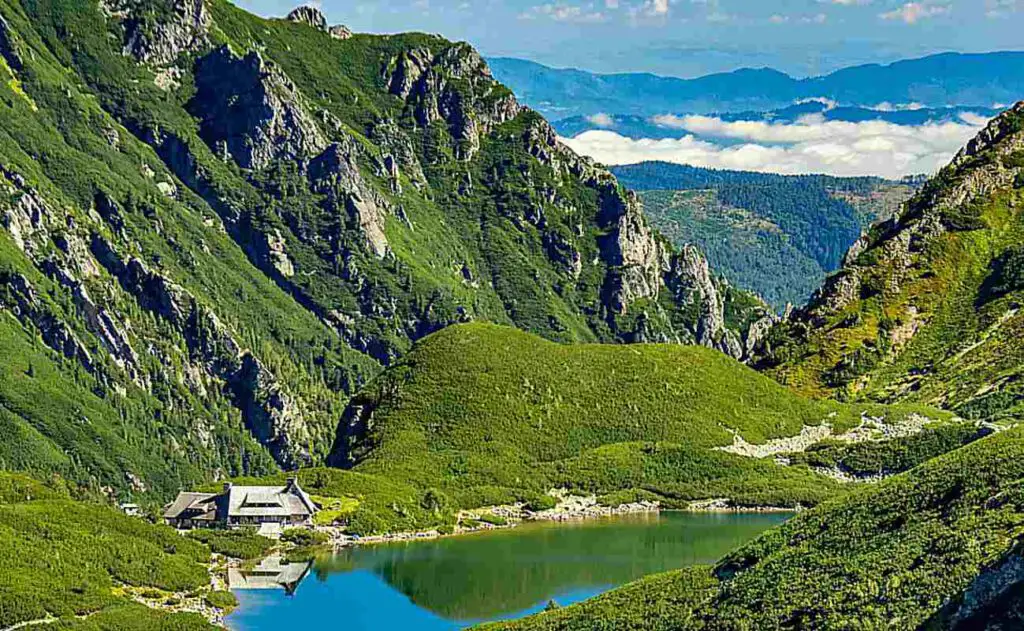
The PTTK shelter in the Valley of Five Polish Ponds serves as an ideal haven for mountain lovers. Constructed between 1947 and 1953 on Przedni Staw Pond, the shelter offers a full sanitary facility, complimentary luggage storage, and a spacious, cozy dining room. It’s worth to say, the sour rye soup with sausage and potatoes, and the apple pie here are must-tries.
The shelter houses 13 rooms that can accommodate 2, 4, 7, 8, or 10 people. If you need to book a room, remember to do it well in advance, sometimes even several months earlier. This popular spot is often bustling with tourists and is frequently used as a base for trips to Krzyżne, Kozi Wierch, or Zadni Granat.
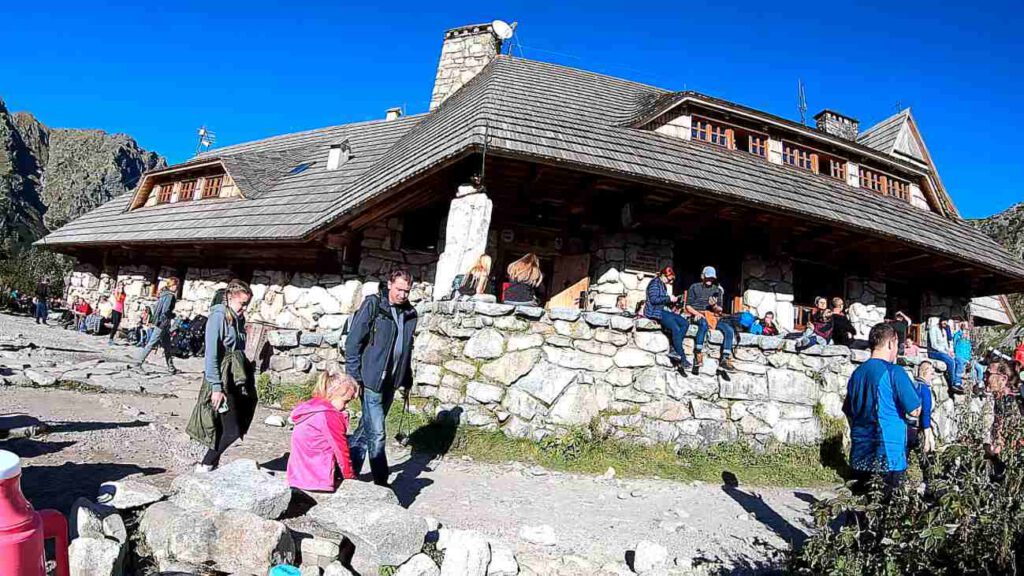
And if you’re a fan of sunrises or sunsets, I am convinced that you’ll love this place. Whenever you plan a trip to the Valley of Five Polish Ponds, make sure to check out this shelter. It has a truly amazing atmosphere.
After a refreshing break at the shelter, it’s time to head back to Palenica Białczańska. I suggest taking the black tourist trail for the descent from the Valley of Five Polish Ponds. It meanders down the slope of Niżnia Kopa (1711 m above sea level) to the Roztoka Valley, offering spectacular views. I believe this route is safer than the one that passes by the Siklawa waterfall.
As you stroll down the narrow path to the Roztoka Valley, you’ll catch a glimpse of the blue trail that leads to Morskie Oko Lake through Świstowa Kopa and Kępa (1683 m). But, let’s save that for another day.
We take our time, descending slowly to the Roztoka Valley, and then trace our steps back to Palenica Białczańska. I know, by this time, we’ll be looking forward to the waiting buses that will transport us back to Zakopane.
The Unique History of the Valley and Its Shelter
The Valley of Five Polish Ponds, believe it or not, was once a pastoral land. It was a possession of the Nowobilski family dating back to 1637, granted by none other than King Władysław IV. It wasn’t until 1876 that the first shelter in Piętastaw, initiated by the Tatra Society, was established at Mały Staw (Small Pond).
Picture this: a tiny, one-room structure built with solid granite blocks.
Ten years later, in 1896, the valley’s popularity grew and it was decided to construct a new, larger, and more comfortable hostel. It featured wooden walls, a stove, and bunks for sleeping.
The Golden Era of the Valley
The 19th century marked the golden era of tourism in the valley. Esteemed visitors included figures like Stanisław Staszic and Seweryn Goszczyński. This was also the time when the first tourist trails were laid out. Let’s travel back to the winter of 1894 when Jan Grzegorzewski and guide Bartłomiej Obrochta were the first to reach the valley.
Sadly, during World War I, the shelter faced multiple devastations. But thanks to the High Mountain Company of the Polish Army, it was restored each time. In 1932, a new shelter was unveiled and, with tourism booming, a decision to expand and insulate it was made the following year.
Figures like Helena Marusarzówna, Stanisław, Jan and Andrzej Marusarz, and Bronisław Czech were among the notable visitors, making the valley a gem of interwar tourism.
Despite surviving World War II, the shelter mysteriously burned down in 1945. Andrzej Krzeptowski and his wife then decided to build another one. By 1947, a modest wooden structure was erected at Mały Staw, which now houses a Tatra National Park Guardhouse.
The Birth of the Current Shelter
Fast forward to 1954, the construction of the current, fifth shelter in the Valley of Five Ponds was completed. Recent developments include the establishment of eco-friendly infrastructure in 2009-2010, with the help of the EkoFundusz Foundation and the National Fund for Environmental Protection and Water Management. This included a small hydropower plant and a sewage treatment plant.
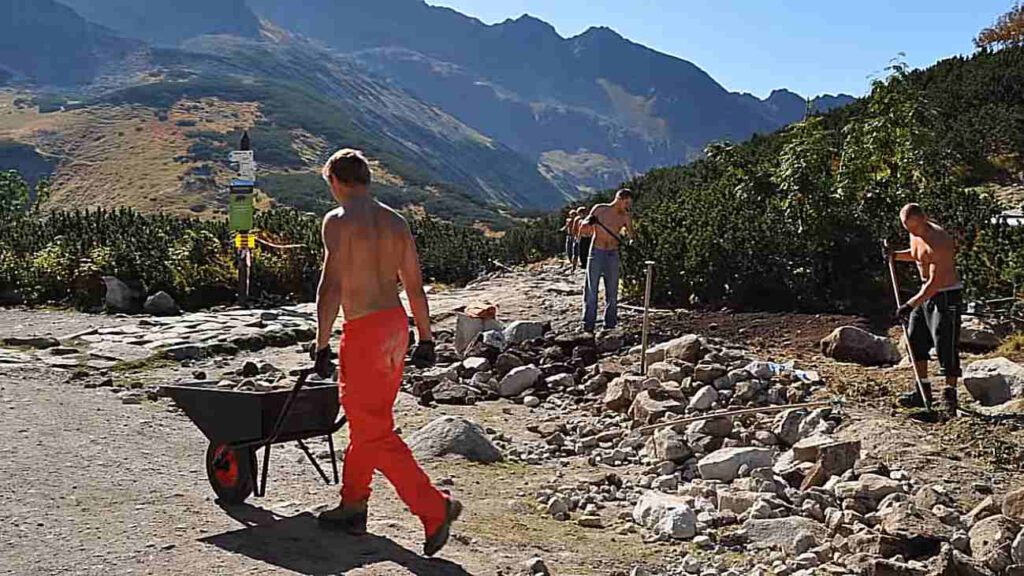
Sheep grazing was a common sight in the valley up until the 1960s. Before World War II, the process of buying hall land from the highlanders had begun. In 1956, the national park began to limit grazing. When the entire valley became the property of the Tatra National Park in 1965, a decision was made to cease shepherding altogether.
References:
- https://www.zakopane.pl/strefa-turystyczna/turystyka/wycieczki-gorskie-latem/szlaki-lato/dolina-roztoki-dolina-pieciu-stawow-polskich
- https://www.obiezyswiaty4.com/dolina-pieciu-stawow-polskich/
- https://pl.wikipedia.org/wiki/Dolina_Pi%C4%99ciu_Staw%C3%B3w_Polskich
- https://pl.wikipedia.org/wiki/Schronisko_PTTK_w_Dolinie_Pi%C4%99ciu_Staw%C3%B3w_Polskich

